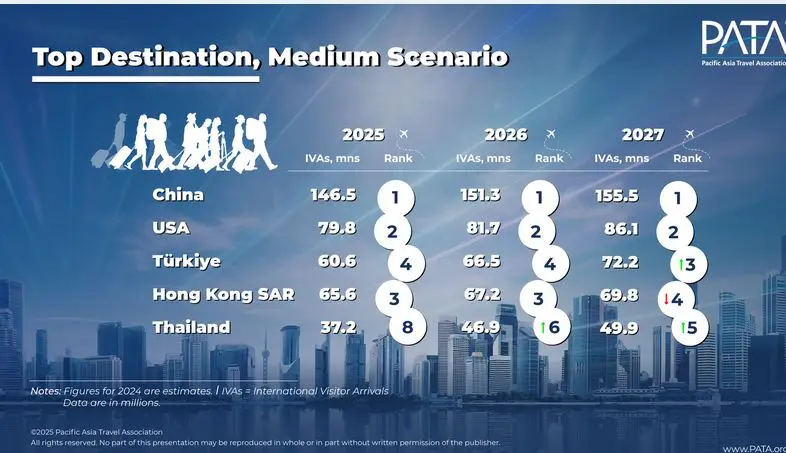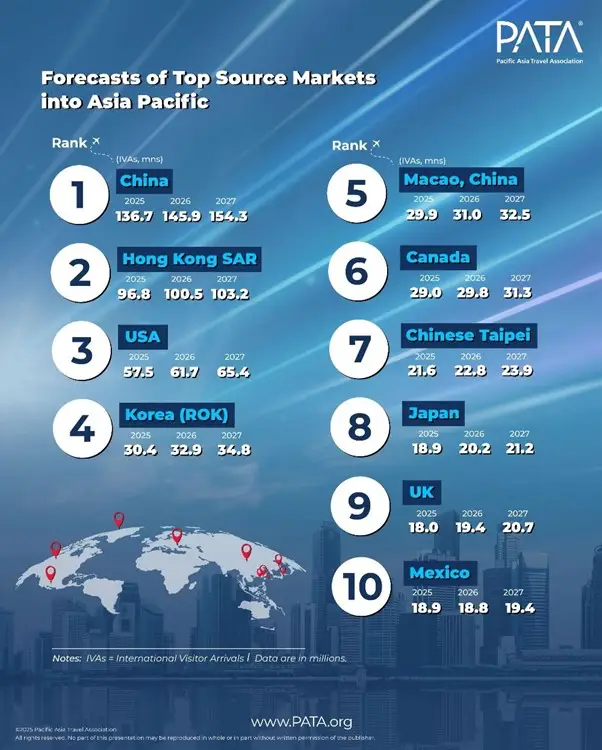International visitor arrivals to Asia Pacific are projected to reach 813.7 million by 2027, reflecting a continued upward trend from the estimated 648.1 million in 2024 according to the latest Asia Pacific Visitor Forecast 2025-2027 released by the Pacific Asia Travel Association (PATA).
Key Highlights from the Asia Pacific Visitor Forecasts 2025-2027
- Resilient Growth Trajectory
Under the medium scenario, international visitor arrivals to Asia Pacific are projected to reach 813.7 million by 2027, reflecting a continued upward trend from the estimated 648.1 million in 2024.
- Policy and Connectivity Driving Recovery
Simplified visa processes, expanded airline routes, and enhanced infrastructure are accelerating recovery. Initiatives such as China’s visa-free transit expansion and Thailand’s “Six Countries, One Destination” project illustrate how strategic policy shifts can drive visitor flows.
- Destination Performance
China is forecast to reclaim its position as the leading inbound destination in the region, with the USA, Türkiye, and Hong Kong ranking among the top performers by 2027. Mongolia, Türkiye, Sri Lanka, and Japan are projected to lead in recovery rates, surpassing their pre-pandemic visitor numbers.
- China: With over 54 million travellers expected to visit Hong Kong and more than 33 million heading to Macao, China remains a dominant force in the region. Popular destinations like Thailand, Japan, and South Korea will continue to attract Chinese travellers.
- USA: By 2027, the Asia Pacific region could see 47 million US visitors. While Canada and Hawaii remain top choices, Türkiye is gaining traction as an increasingly popular choice for American travellers.
- South Korea: Korean travel patterns are expected to revert to pre-pandemic norms, with strong interest in Japan, China, and Vietnam. At the same time, destinations like Thailand and Malaysia are poised to become even more popular among Korean tourists.
- Canada: The US is projected to welcome over 23 million Canadian visitors, reinforcing its position as the top destination. However, Canadian interest in Asia Pacific is on the rise, with more travellers eyeing destinations like China, Japan, India, and Hawaii.
- Top Source Markets
China is expected to maintain its role as the largest source market for Asia Pacific, followed by the USA, Hong Kong, South Korea, and India. The rising middle class in India and Southeast Asia, along with increased adoption of digital payment platforms and social media-driven travel inspiration, is fuelling outbound travel growth.
- Macro Trends Impacting the Visitor Economy
The Asia Pacific tourism landscape will continue to be shaped by economic shifts, geopolitical factors, and technological advancements. Digital transformation, sustainable tourism initiatives, and new transportation infrastructure are set to redefine travel experiences in the region.
This report, prepared in collaboration with the Hospitality and Tourism Research Centre of the School of Hotel and Tourism Management at The Hong Kong Polytechnic University, presents forecasts for 39 destinations in the Asia Pacific region under mild, medium, and severe scenarios, offering critical insights for stakeholders in the travel and tourism industry.
Two Factors to Shape Asia Pacific Travel and Tourism by 2027
In an earlier report, PATA also outlined two significant trends which are expected to continue through 2025-2027, one of which is the increasing demand for wellness-focused travel. The pandemic has accelerated this shift, with travellers prioritising health and wellbeing.
This translates to a surge in interest in destinations offering preventative health practices, such as yoga and hot springs, as well as opportunities for digital detox. Furthermore, travellers are increasingly conscious of sustainability, favouring eco-friendly products and experiences over mass tourism.
For example, based on these projections, Hong Kong and Macao could benefit from developing health programmes tailored to Chinese travellers. Meanwhile, Türkiye may unlock new opportunities in wellness tourism by investing in offerings that align with American travellers’ preferences.
Unpredictable Global Geopolitics
External factors, such as trade policies, tariffs, and visa regulations, significantly influence travel patterns within the Asia Pacific region, and are expected to continue to do so through the 2025-2027 period. Price increases and supply chain disruptions resulting from trade policies can impact both inbound and outbound travel. Similarly, currency fluctuations can affect destination affordability, with devaluation potentially boosting inbound tourism.
Environmental and ethical concerns are also reshaping travel choices—travellers are increasingly seeking sustainable products and experiences, reflecting a broader shift towards responsible travel.
To navigate the complexities of global geopolitics and shifting travel patterns, tourism businesses need to stay informed about geopolitical developments and their potential impact on travel patterns. Monitoring trade policies, visa regulations, and currency fluctuations will allow businesses to anticipate and adapt to changes.

















